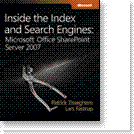It has been an extremely busy last couple of weeks but Lars Fastrup and I have finished the writing on our new baby: a full book for administrators and developers who want to learn about the internals, the customization and development options for the indexing and the search infrastructure delivered with the Microsoft Office SharePoint Server 2007. We are now in the process of reviewing all of the work and we expect the book to be in the shops around April 2008.

I really enjoyed writing this book since search is one of of my favorite topics in the world of MOSS and it deserves its own dedicated book. Here is the list of chapters with a small overview we are covering:
Chapter 01 - Introducing Enterprise Search
An introductory chapter with an overview of the indexing and search capabilities, the core components in the architecture and a discussion of the new Search Server 2008 with its support for federated search.
Chapter 02 - The End-User Search Experience
This chapter covers what is there immediately out-of-the box for the end-users with a discussion about the use of the small Search Box and the Search Center. There is also a detailed discussion of the various options there are to formulate a keyword syntax query.
Chapter 03 - Customizing the Search Experience
One my favorite chapters. We discuss first the configuration tasks that administrators can do in the Search Center with the coverage of the properties exposed by the different Search Web Parts. Next, we dive deep into the XSL that is used to transform the search results in the HTML that is displayed to the user. To conclude there is coverage about the classes in the search object model for a programmatic approach to customizing the Search Center and the way you can replace the small Search Box with your own custom one.
Chapter 04 - Search Usage Reports
Here we discuss the support for gathering and analyzing what the users are doing when searching. After a discussion of the report architecture, we discuss the search query and next the search results reports and how you can benefit from it as an administrator to finetune the end-user search experience.
Chapter 05 - Search Administration
There is often a thin line between administrators and developers when it comes to search. This 100 pages module discusses all the aspects of performing administration tasks for both the index and the search engine. We also included at the end a discussion on how to use Powershell to automate some of these tasks.
Chapter 06 - Indexing and Searching Business Data
This chapter is all about the Business Data Catalog and how you can create content sources that will enable the crawler to index your business data. You'll learn how to prepare your application definition files and how to create content sources, search scopes, expose managed properties and customize the search experience when it comes to business data. There is also some coverage on the BDC runtime object model so that developers can build custom solutions that benefit from the work done by the administrators.
Chapter 07 - Search Deployment Considerations
In this chapter we give insight in best practices and guidelines on how to plan for and set up your search topology, and monitor the performance of the indexing and the searching.
Chapter 08 - Search APIs
This big chapter covers the two object models that are part of the Search API: the administration object model and the query object model. There is also coverage of the Query Web service in detail.
Chapter 09 - Advanced Topics
A final big chapter is all about writing protocol handlers and IFilters, with also sections on how to build custom security trimmers and add support for faceted search within your MOSS environment.
Chapter 10 - WSS 3.0 Search Support
One of the big changes regarding search support in WSS is that is now uses the same architecture as MOSS. So many of the things discussed in the book can also be applied to pure WSS installations.